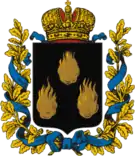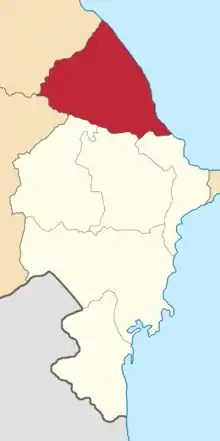Kuba uezd
The Kuba uezd[lower-alpha 1] was a county (uezd) within the Baku Governorate of Russian Empire and then of Azerbaijan Democratic Republic and Azerbaijan SSR until its formal abolition in 1929 by Soviet authorities. The uezd was located in northern part of the Baku Governorate, bordering Caspian sea to the east, Elizavetpol Governorate to the west, Dagestan Oblast to the north, the Geokchay, Shemakha, and Baku uezds to the south.[1] The administrative center of the uezd was the city of Kuba (present-day Quba).
Kuba uezd
Кубинскій уѣздъ | |
|---|---|
 Coat of arms | |
 Location in the Baku Governorate | |
| Country | Russian Empire |
| Viceroyalty | Caucasus |
| Governorate | Baku |
| Established | 1840 |
| Abolished | 1929 |
| Capital | Kuba (present-day Quba) |
| Area | |
| • Total | 7,179.59 km2 (2,772.06 sq mi) |
| Population (1916) | |
| • Total | 198,204 |
| • Density | 28/km2 (72/sq mi) |
| • Urban | 13.60% |
| • Rural | 86.40% |
Administrative divisions
The subcounties (uchastoks) of the Kuba uezd in 1912 were as follows:[2]
| Uchastok | Russian name | 1912 population | Area |
|---|---|---|---|
| Divichinsky | Дивичинскій участокъ | 41,569 | 1,764.78 square versts (2,008.43 km2; 775.46 sq mi) |
| Kubinsky | Кубинскій участокъ | 54,113 | 1,855.78 square versts (2,111.99 km2; 815.45 sq mi) |
| Kusarsky | Кусарскій участокъ | 53,645 | 1,437.34 square versts (1,635.78 km2; 631.58 sq mi) |
| Myushkyursky | Мюшкюрскій участокъ | 16,540 | 1,250.71 square versts (1,423.39 km2; 549.57 sq mi) |
Geography
The uezd was located on the northern slope of the eastern part of Greater Caucasus mountain range, mainly consisting of 3 main parts: Mountains, which occupies most parts of the south-west, foothills, covering most of the uezd from southwest to northeast, and lowlands, mostly in the areas bordering the Caspian sea. The highest point in the uezd, Shahdagh, is located at the western part of the uezd at 13,951 feet.[3]
The three main rivers in the uezd were Qudyal, Gilgil and Qusarchay. The Samur river formed the northern border.[3]
History
After the capture of the Quba Khanate by the Russian forces in 1806, during the Russo-Persian War (1804–1813), the khanate was removed and was made a province of the Russian Empire. The uezd was created in 1840 and was initially made part of the Caspian Oblast in the same year, and later part of the Shamakhi Governorate in 1846. Due to an earthquake in Shamakhi in 1859, the centre of the Shamakhi Governorate was moved from Shamakhi to Baku and the governorate was renamed Baku Governorate.[4]
In 1918, after the collapse of the Russian Empire, Azerbaijan became part of Transcaucasian Democratic Federative Republic. After the establishment of the Baku Commune in April 1918,[5] clashes began in the city of Baku and other uezds within the Baku Governorate,[6] called the March Days, during which 12,000 Azerbaijanis and other Muslims and 2,500 Armenians died.[7][8][9]
On 28 May 1918, the Azerbaijan Democratic Republic declared its independence and the uezd was kept as part of its administrative units. After the Red Army invasion of Azerbaijan in 1920, Azerbaijan was integrated into the Soviet Union and the uezd was abolished by Soviet authorities in 1929.
Demographics
Russian Empire Census
According to the Russian Empire Census, the Kuba uezd had a population of 183,242 on 28 January [O.S. 15 January] 1897, including 96,771 men and 86,471 women. The plurality of the population indicated Tatar[lower-alpha 2] to be their mother tongue, with significant Tat, Kyurin, and Kazi-Kumukh speaking minorities.[12]
| Language | Native speakers | % |
|---|---|---|
| Tatar[lower-alpha 2] | 70,150 | 38.28 |
| Tat | 46,430 | 25.34 |
| Kyurin | 44,756 | 24.42 |
| Kazi-Kumukh | 11,614 | 6.34 |
| Jewish | 3,972 | 2.17 |
| Russian | 2,516 | 1.37 |
| Ukrainian | 1,426 | 0.78 |
| Armenian | 1,191 | 0.65 |
| Persian | 549 | 0.30 |
| Turkish | 216 | 0.12 |
| Avar-Andean | 97 | 0.05 |
| Georgian | 66 | 0.04 |
| Polish | 64 | 0.03 |
| German | 38 | 0.02 |
| Belarusian | 29 | 0.02 |
| Lithuanian | 5 | 0.00 |
| Mordovian | 1 | 0.00 |
| Other | 122 | 0.07 |
| TOTAL | 183,242 | 100.00 |
Kavkazskiy kalendar
According to the 1917 publication of Kavkazskiy kalendar, the Kuba uezd had a population of 198,204 on 14 January [O.S. 1 January] 1916, including 105,556 men and 92,648 women, 196,077 of whom were the permanent population, and 2,127 were temporary residents:[13]
| Nationality | Urban | Rural | TOTAL | |||
|---|---|---|---|---|---|---|
| Number | % | Number | % | Number | % | |
| Sunni Muslims[lower-alpha 3] | 4,218 | 15.65 | 102,472 | 59.84 | 106,690 | 53.83 |
| North Caucasians | 417 | 1.55 | 48,688 | 28.43 | 49,105 | 24.77 |
| Shia Muslims[lower-alpha 4] | 6,830 | 25.34 | 13,627 | 7.96 | 20,457 | 10.32 |
| Jews | 14,713 | 54.58 | 322 | 0.19 | 15,035 | 7.59 |
| Russians | 177 | 0.66 | 5,206 | 3.04 | 5,383 | 2.72 |
| Armenians | 579 | 2.15 | 933 | 0.54 | 1,512 | 0.76 |
| Asiatic Christians | 22 | 0.08 | 0 | 0.00 | 22 | 0.01 |
| TOTAL | 26,956 | 100.00 | 171,248 | 100.00 | 198,204 | 100.00 |
Notes
-
- Russian: Куби́нскій уѣ́здъ, romanized: Kubínsky uyézd
- Azerbaijani: قوبا قضاسی, romanized: Qūbā qaz̤āsı
- Before 1918, Azerbaijanis were generally known as "Tatars". This term, employed by the Russians, referred to Turkic-speaking Muslims of the South Caucasus. After 1918, with the establishment of the Azerbaijan Democratic Republic and "especially during the Soviet era", the Tatar group identified itself as "Azerbaijani".[10][11]
- Primarily Turco-Tatars.[14]
- Primarily Tatars.[14]
References
- Tsutsiev 2014, p. 59.
- Кавказский календарь на 1913 год, pp. 140–143.
- "Большой энциклопедический словарь Брокгауза и Ефрона. Агдаш" [Brockhaus and Efron Encyclopedia Dictionary. Kuba]. Retrieved 2011-08-05.
- "Administrative Territorial Division" (PDF). preslib.az. p. 9.
- Hopkirk, Peter. On Secret Service East of Constantinople: The Plot to Bring Down the British Empire, Oxford University Press, 2001; ISBN 0-19-280230-5, pp 304–5, 322
- Shahumyan, Stepan (1959). Letters 1896–1918. Yerevan: State Publishing House of Armenia. pp. 63–67.
On one side were fighting the Soviet Red Guard; the Red International Army, recently organized by us; the Red Fleet, which we had succeeded in reorganizing in a short time; and Armenian national units. On the other side the Muslim Savage Division in which there were quite a few Russian officers, and bands of armed Muslims, led by the Musavat Party... For us the results of the battle were brilliant. The destruction of the enemy was complete... More than three thousand were killed on both sides
- Pasdermadjian, Garegin (1918). Why Armenia Should be Free: Armenia's Role in the Present War. The Armenian National Union of America. pp. 188–199.
- Minahan, James B. (1998). Miniature Empires: A Historical Dictionary of the Newly Independent States. p. 22. ISBN 0-313-30610-9.
The tensions and fighting between the Azeris and the Armenians in the federation culminated in the massacre of some 12,000 Azeris in Baku by radical Armenians and Bolshevik troops in March 1918
- Michael Smith. "Pamiat' ob utratakh i Azerbaidzhanskoe obshchestvo/Traumatic Loss and Azerbaijani. National Memory". Azerbaidzhan i Rossiia: obshchestva i gosudarstva (Azerbaijan and Russia: Societies and States) (in Russian). Sakharov Center. Retrieved 21 August 2011.
- Bournoutian 2018, p. 35 (note 25).
- Tsutsiev 2014, p. 50.
- "Population of Kuba Uyezd (1897)". Demoskop Weekly (in Russian).
- Кавказский календарь на 1917 год, pp. 178–181.
- Hovannisian 1971, p. 67.
- "Population of Kuba Uyezd". Demoskop Weekly.
Bibliography
- Bournoutian, George A. (2018). Armenia and Imperial Decline: The Yerevan Province, 1900–1914. Milton Park, Abingdon, Oxon: Routledge. ISBN 978-1-351-06260-2. OCLC 1037283914.
- Hovannisian, Richard G. (1971). The Republic of Armenia: The First Year, 1918–1919. Vol. 1. Berkeley: University of California Press. ISBN 978-0520019843.
- Кавказский календарь на 1913 год [Caucasian calendar for 1913] (in Russian) (68th ed.). Tiflis: Tipografiya kantselyarii Ye.I.V. na Kavkaze, kazenny dom. 1913. Archived from the original on 19 April 2022.
- Кавказский календарь на 1917 год [Caucasian calendar for 1917] (in Russian) (72nd ed.). Tiflis: Tipografiya kantselyarii Ye.I.V. na Kavkaze, kazenny dom. 1917. Archived from the original on 4 November 2021.
- Tsutsiev, Arthur (2014). Atlas of the Ethno-Political History of the Caucasus (PDF). Translated by Nora Seligman Favorov. New Haven: Yale University Press. ISBN 9780300153088. Archived (PDF) from the original on 17 June 2023.